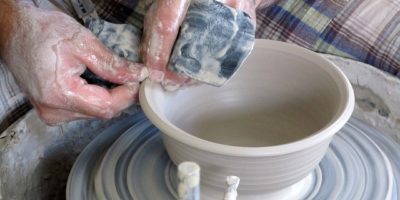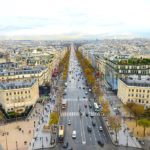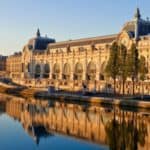The Man Who Designed Paris: Georges-Eugène Haussmann
Paris wasn’t always the beautifully manicured city we see today. In fact, as recently as the mid 19th century, Paris was dirty, crowded and filled with disease! Not exactly the “City of Light” we all know and love!
Enter: Napoleon III and Paris’ city prefect at the time, Georges-Eugène Haussmann, also known as Baron Haussmann. Mr. Haussmann is responsible for the wide boulevards lined with trees, the 20 different arrondissements and the general architectural look of Paris today.
While we may love what Haussmann did with the city, his plans weren’t always met with support. Paris’ path to Haussmannian architecture is filled with ups and downs, which I’ll be mapping out for you below!
Keep reading for all you need to know about Georges-Eugène Haussmann.
Haussmann’s early life and career
Georges-Eugène Haussmann was born in Paris in 1809. He was a studious child, and went on to study law, and also music! Haussmann studied at the Paris Conservatory and it is said that he was a talented musician.
Rather than pursue music, Haussmann decided to go into public administration. His career began in 1831, and he worked in numerous positions before becoming the prefect of Paris.
Before I tell you how, I want to set the historical scene a bit. Louis-Napoleon Bonaparte III, Napoleon Bonaparte’s nephew, was the first French president to ever be elected in 1848. As soon as he got into office, Bonaparte began some ambitious projects. This included connecting the Louvre and the Hôtel de Ville by lengthening the rue de Rivoli, and the creation of the Bois de Boulogne on the western side of the city.
Bonaparte began to get really frustrated with the progress of his projects. They were taking too long! Bonaparte blamed the current prefect, Jean-Jacques Berger for the delays. It was probably due to this that he began to think about replacing him.
But, before Bonaparte could move forward with his grand plans for Paris, there was something else standing in his way. By French law, he couldn’t be re-elected when his presidency reached term. The public loved him, and Bonaparte was determined to stay in office.
In 1851, Bonaparte staged a coup d’état and named himself the new Emperor of France, and began calling himself Napoleon III after his uncle. Although the government didn’t approve, the French people were thrilled to find out that Bonaparte would continue to rule over France as Napoleon III.
Napoleon III almost immediately began to look for a new prefect to replace Berger and make his grand plans for Paris come to light. He found Haussmann soon after!
The remodel of a lifetime

Paris in 1838 as seen by Louis Daguerre. This is the first picture to ever contain a human being, and also shows the condition of Paris at the time – Flickr
In order to find a new prefect for Paris, Napoleon III sent the minister of the interior to interview the prefects throughout France to see if any of them qualified for the job. At the time, Haussmann was the prefect of the Yonne region.
The minister of the interior was immediately impressed with Haussmann, and sent him directly to Paris to speak to Napoleon III. Haussmann was officially made the prefect of Paris in 1853. He was immediately tasked with making Paris healthier, safer, and more enjoyable to live in.
“Paris, needed light, air, clean water and good sanitation.” Napoleon III
Paris was in desperate need of change. It’s population had doubled in just 50 years, reaching 1 million habitants. Things hadn’t changed much in Paris since King Louis XIV was around, and the city was practically caving in on itself because of the poverty, disease and overcrowding.
Not only was it becoming unbearable to live in the capital city, literally thousands were dying from diseases such as cholera. In 1832, the disease took 3,500 lives in just one week! Something really needed to be done to make Paris liveable.
The project began! First up? To make Paris more sanitary. Before Haussmann, Napoleon III and their architects could get to work on the new aesthetics of the city, they had to make it cleaner. What good is a pretty city if everyone who lives there is sick and dying?
Haussmann knew that he needed to purify and decontaminate the water supply. There already was a sewer system in place but it was old and falling apart. Haussmann appointed a man named Eugene Belgrand as the Director of Water and Sewers of Paris, and the pair came up with ideas to make water safer and drinkable. They created a sort of city under Paris that would process water waste and bring potable water into the city.
A new Paris

This 1853 map of Paris indicates the newly inaugurated streets, as well as those under construction, under Haussmann’s plans to modernize the city – WikiCommons
In addition to making Paris more sanitary, Napoleon III wanted to make Paris much more appealing to the eye. He had just lived in exile in London for 12 years before returning to France, where he left impressed by the parks and large avenues. Napoleon III couldn’t understand why Paris couldn’t follow suit, or be even more beautiful than, London!
Haussmann expanded the area of Paris in order to accommodate the growing population. When he was made prefect, there were just 12, small and cramped, arrondissements in the city. If you’ve ever been to Paris, you know that the capital is separated into 20 different neighborhoods, called arrondissements.
Today, the same system that Haussmann created in still in place, with the neighborhoods beginning in the center of the city with the 1st arrondissement, and spiralling out clockwise until the 20th arrondissement in the east.
Napoleon III was really strict about what would go into his new Paris. He ordered 80 kilometres of new boulevards to be installed in order to connect the important points of the city. All of the buildings on the new boulevards needed to be the same height, with similar styles. French author Victor Hugo was a famous critic of the project, and he has been cited as saying that one couldn’t tell what they were standing in front of: an apartment, a theatre, or a store, as everything looked alike.
Haussmann was also the first to numeration of homes and businesses. He is also the one who decided which side of the road Parisians would drive on (the right side). He implemented the first public transportation system that was easy and affordable.
2 new train stations were built during the time: the Gare de Lyon and Gare du Nord in order to connect Paris to the rest of France. Les Halles, the ancient Hôtel-Dieu hospital, and the Opéra Garnier were completed as well. The Bois de Boulogne, Bois de Vincennes, Parc des Buttes-Chaumont and the Parc Montsouris were completed. The Parc Monceau and the Jardin de Luxembourg were reclaimed from their noble owners and were opened to the public. There were so many changes in Paris at this time that it’s hard to keep up!
To show his appreciation for his hard work, Napoleon III gave the prefect the honorary title of Baron Haussmann, although this was strictly honorary and gave him no sort of power.
Paris was a massive construction site for 17 years, and for some time after as well! By the end of the remodel in 1870, 1 in 5 Parisians worked in construction and building. While some were happy with the work, there were many that did not agree with Napoleon III and Haussmann.
Haussmann: the man who remains misunderstood
There are some that say that Napoleon III and Haussmann wanted to remodel Paris for the purpose of controlling the public in a more efficient way. By the time Napoleon III was in charge, in the past 25 years there had been 9 uprisings from the people.
Napoleon seemed to have noticed that the small streets made it easier for revolutionaries to keep the police and military out. There are some that say this was the real reason why Napoleon III wanted those large boulevards and open spaces: so that his army could break through if necessary.
Napoleon III also didn’t seem to have any problems with laying down streets and parks in the slums of the city, displacing thousands of Parisians against their will. Parisians that did not want to live in the new, outer arrondissements but were forced there anyways.
It is because of these theories surrounding the renovations that Haussmann has been villainized in the past. He was the face of the project and therefore had to deal with many unhappy critics. Although the remodel wasn’t even Haussmann’s original idea, he was criticized for following the orders of Napoleon III.
Haussmann was also severely criticized after the remodel, as the French people weren’t happy with all of the money that he spent. In order to stay in the good graces of his people, Napoleon III dismissed Haussmann in the late 1860s.
To his harshest critics, Haussmann ripped out the history of Paris with his remodel. To those that appreciate his work, he changed the face of Paris forever. I’ll let you all decide how you feel!
Conclusion
Whether you love him, or you hate him, it’s clear that Georges-Eugène Haussmann completed changed Paris in less that 20 years. He helped design the Paris that we all appreciate today, so for me personally, he’s not all bad! At least on the surface level. But that’s another political and social debate for another day. Er, blog.
If you’d like to pay homage to Mr. Haussmann, you can find his grave in the Père Lachaise Cemetery.
If you’d like to learn more about Paris, and see those wide boulevards and rolling parks for yourselves, why not join a walking tour with one of our amazing local guides? Click here to learn more…and sign up!
Planning a trip to Paris ? Get ready !
These are Amazon’s best-selling travel products that you may need for coming to Paris.
Bookstore
- The best travel book : Rick Steves – Paris 2023 – Learn more here
- Fodor’s Paris 2024 – Learn more here
Travel Gear
- Venture Pal Lightweight Backpack – Learn more here
- Samsonite Winfield 2 28″ Luggage – Learn more here
- Swig Savvy’s Stainless Steel Insulated Water Bottle – Learn more here
Check Amazon’s best-seller list for the most popular travel accessories. We sometimes read this list just to find out what new travel products people are buying.













